Electric Blinds for Skylights
- malik tanveer
- Oct 1
- 4 min read

Skylights are a beautiful feature in many homes, bringing in natural light, improving ventilation, and creating a sense of openness. However, with all the benefits they provide, skylights can sometimes let in too much heat, light, or glare. That is where electric blinds for skylights come into play. These modern shading solutions combine functionality with convenience, allowing homeowners to maintain comfort and control without sacrificing style.
Why Skylight Shading Matters
While skylights brighten a room, they can also create challenges. Direct sunlight through a roof window can overheat a space, fade furniture, or make it difficult to watch television or use electronic screens. At night, skylights can let in streetlight glare or moonlight, disrupting sleep in bedrooms. In colder months, they may also contribute to heat loss. Installing blinds provides a solution by regulating light and temperature, and when those blinds are electrically powered, the advantages increase significantly.
What Are Electric Skylight Blinds?
Electric blinds for skylights are window coverings designed specifically for roof windows, operated by a motor rather than manual effort. Since skylights are often positioned in hard-to-reach places, traditional cords or rods can be inconvenient. Electric blinds eliminate the struggle by allowing control through a remote, wall switch, or even smart home integration. With the push of a button, homeowners can adjust blinds to block or filter sunlight at any time of day.
Types of Electric Blinds for Skylights
Electric skylight blinds come in a range of styles and fabrics, each serving a different purpose. Some popular options include:
Blackout blinds: Ideal for bedrooms and home cinemas, these provide near-total darkness and are excellent for sleep or reducing glare.
Light-filtering blinds: These soften incoming light without completely blocking it, creating a gentle glow while reducing harsh glare.
Thermal blinds: Designed with energy efficiency in mind, thermal blinds help insulate rooms, keeping heat in during winter and reducing solar gain in summer.
Venetian or slatted blinds: Though less common in skylights, motorized venetian styles allow precise control over the angle of light.
The choice of blind depends on the room’s purpose, décor, and energy efficiency needs.
Benefits of Electric Skylight Blinds
Convenience and Accessibility
One of the biggest benefits is ease of use. Since skylights are usually out of reach, operating blinds manually can be awkward or even dangerous. Electric blinds solve this problem by giving instant control at the press of a button.
Enhanced Comfort
Electric blinds make it easy to adjust light levels and temperature throughout the day. They can be closed during the hottest part of the afternoon to prevent overheating or motorised awnings in Winchester opened in winter to let in sunlight and warmth.
Smart Home Integration
Many modern electric skylight blinds can be connected to smart home systems. This allows scheduling, voice control, and even automated adjustment based on sunlight levels or room temperature. For example, blinds can close automatically when the sun is strongest, helping to save on cooling costs.
Energy Efficiency
By controlling solar gain and heat loss, electric skylight blinds help regulate indoor temperatures more effectively. This reduces reliance on heating and air conditioning, lowering energy bills.
Aesthetic Appeal
Electric blinds are designed with sleek mechanics that integrate seamlessly with skylights. Many are discreet when not in use, preserving the clean lines of the ceiling.
Installation and Power Options
Electric blinds can be powered in different ways, depending on the skylight type and homeowner preference.
Mains powered: These blinds are hardwired into the home’s electrical system, offering reliable performance and often working well with home automation.
Battery powered: A good option for retrofits, battery-operated blinds are easy to install without major wiring work.
Solar powered: Eco-friendly and efficient, solar blinds use a small panel near the skylight to generate power. They are ideal for hard-to-reach roof windows and reduce dependence on mains electricity.
Professional installation is often recommended, particularly for mains-powered systems, to ensure safe wiring and seamless integration.
Choosing the Right Electric Skylight Blinds
When selecting blinds, consider factors such as:
The room’s purpose (bedroom, living room, office).
Desired level of light control (blackout vs. light-filtering).
Energy efficiency goals.
Compatibility with existing smart home systems.
Style and color options that match interior décor.
It is also worth considering the skylight brand and model, as many manufacturers provide blinds designed specifically to fit their windows.
Maintenance and Care
Electric skylight blinds are relatively low maintenance. Dusting or lightly vacuuming the fabric keeps them looking fresh. For long-term performance, it is important to occasionally check the motor and power supply. With proper care, they can last many years while continuing to provide smooth, reliable operation.
Conclusion
Electric blinds for skylights bring together practicality, comfort, and modern technology. They offer a perfect solution for managing light, heat, and privacy in spaces where traditional blinds are difficult to use. With options ranging from blackout to thermal and solar-powered systems, they can be tailored to suit different rooms and lifestyles. As homes become smarter and more energy-efficient, electric skylight blinds are proving to be more than just a luxury—they are a functional investment that enhances both comfort and style.


Comments